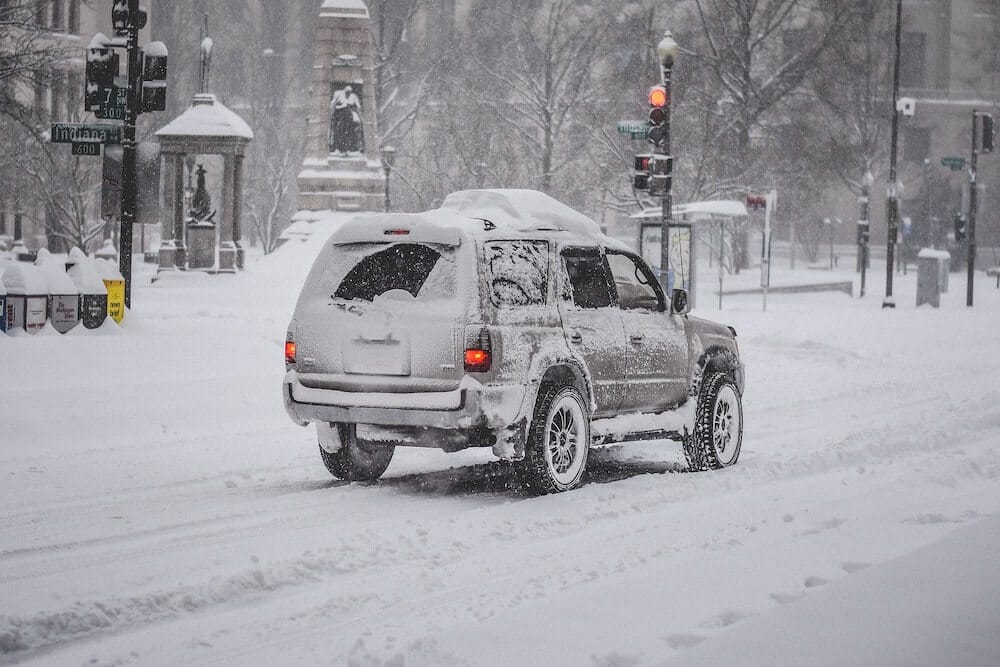What Happens When a Driver Doesn’t Clear Snow Off Their Car?
What happens when a driver doesn’t clear snow off their car in Illinois? State laws tell us that a motorist may be fined if they fail to uphold their duty to keep their vehicle windows, mirrors, and lights clear. And when it comes to filing car accident claims, a driver whose negligence in winter vehicle maintenance leads to another person’s injuries may be liable for damages.
Let’s take a look at the state laws regulating vehicle snow removal and why these laws are so important for safe road travel in Illinois.
Is It Illegal to Drive With Snow on Your Car in Illinois?
State troopers and local police officers across Illinois report that they are forced to remind motorists every winter of the dangers of driving with snow and ice on their vehicles. For some drivers, clearing the remnants of winter storms from their vehicles is an annoyance they’d rather not deal with. But neglecting to take the extra few minutes to clear car windows and mirrors before driving puts more than just the driver at risk.
Scraping ice off your car windows may seem like an insignificant or needless task when you’re running late for work, but a simple act of carelessness can result in severe injuries to you, another motorist, or a pedestrian you don’t see crossing the street.
State law prohibits any driver from operating a vehicle with obstructions blocking the windows or mirrors. Illinois state law mandates that “windshields must be unobstructed and equipped with wipers.” Unlawful obstructions include snow and ice. The law speaks specifically to vehicle owners dealing with winter weather. In Illinois, no motorist may operate a motor vehicle with “snow, ice, moisture, or other material on any of the windows or mirrors.”
The Quick Guide to Safe Driving published by the Illinois Secretary of State’s Office provides further guidance on safe winter driving. Vehicle owners are instructed to remove all snow and ice from the vehicle, clear all windows, and wait until the windshield is defrosted and clear before driving. A vehicle must have non-freezing windshield washer liquid and visible headlights and taillights.
If snow, ice, or anything else obstructs the driver’s clear view of the highway, it’s a violation of state law to operate the vehicle. Additionally, all motor vehicles except motorcycles must be equipped with windshield wipers and fluid capable of cleaning rain, snow, moisture, or other obstructions from the vehicle’s windshield.
In short, it is against the law to drive with snow or ice covering your vehicle in Illinois, and motorists in violation of these laws may be subject to fines.
Can Not Clearing Snow Off Your Car Cause an Accident?
Driving with your windows, mirrors, or lights covered in snow or ice is not safe under any circumstances. Icy windows obstruct visibility. Snow mattresses (snow piled on a car roof) can slide onto the windshield or into the road. Obscured headlights and taillights make it difficult for other drivers to see your vehicle. There are many types of accidents that can occur when a driver doesn’t take the time to clear their car before driving. These can include:
- Striking a pedestrian due to obscured windows.
- Slow reaction times because of limited visibility, causing rear-end collisions, T-bone accidents, or other types of crashes.
- Accidents caused by driver distraction when snow slides and blocks the windshield.
- Shattered windshields when ice flies off a moving vehicle and hits the car behind them.
- Being struck by another vehicle when the driver doesn’t see your obscured headlights or taillights.
Winter Safety Tips for Driving in Snow and Ice
Winter is the most dangerous season for driving. The singular conditions created by a combination of snow, ice, frigid temperatures, and shortened daylight hours pose hazards that drivers don’t face other times of the year. To avoid an accident, it’s necessary for drivers to practice excessive caution when taking to the roads and streets of their city.
Winter roads are unpredictable. There’s no speed, even the posted speed limit, that can be considered safe on all roads in the winter. When sun and shade hit alternate sections of the road, black ice can lurk where a driver least expects it. Conditions can vary drastically depending on the texture of the road surface and how thoroughly it was plowed and salted. Even one street block can be much more dangerous than the block before it. For a driver, remaining on guard and avoiding distractions becomes even more important in the winter.
According to the Illinois safe driving guide, adverse weather conditions can create extreme hazards on the road. Drivers need to adjust their normal behaviors to these conditions. The following tips for driving in snow and ice can help keep Illinois motorists stay safe during winter months:
- Keep extra distance between your car and the vehicle in front of you. Braking distances are longer on slippery surfaces.
- Avoid sudden braking or acceleration.
- Maintain a low speed. Drive slower than the posted speed limit.
- Don’t use cruise control on wet, snowy, or icy pavement.
- Take turns cautiously. Do not steer sharply on slippery surfaces.
- Gently test your brakes early when preparing to stop. Use slow, steady strokes to brake.
- Beware of bridges, shaded spots, and overpasses which may remain icy after other parts of the road have cleared.
- Keep lights, brakes, windshield wipers, defrosters, radiators, and other auto parts in good working order.
- Use snow tires or snow chains when needed and allowed.
- Keep an emergency supply kit in your vehicle. Include practical supplies like a shovel, ice scraper, and warm blankets.
What Happens When a Driver Doesn’t Clean Their Car and Causes a Crash?
If a driver’s failure to clean snow and ice from their vehicle results in injuries to another person, they may be found liable for the accident. Your personal injury lawyer will need to work with you to prove fault after a car accident that caused your injuries and losses. By examining the circumstances that led to the crash, your car accident attorney can determine whether the other driver acted negligently.
Negligence means that a person failed to behave with the level of care a reasonable individual would have exercised under the same circumstances. Not taking the care to clear snow and ice from the vehicle, as is required by law, may be considered negligence in a car accident case.
As Chicago car accident lawyers, we know that driving through Chicago can be difficult, even under the best of conditions. It’s therefore essential that Illinois vehicle owners do everything in their power to drive prudently when winter weather strikes.
If you were injured because another driver failed to consider the safety of others on the road around them, you may be entitled to take legal action to recover compensation for your losses. An experienced attorney from our firm can review your case details and provide an honest opinion regarding the strengths and weaknesses of your case. Contact our office for a free case evaluation.











